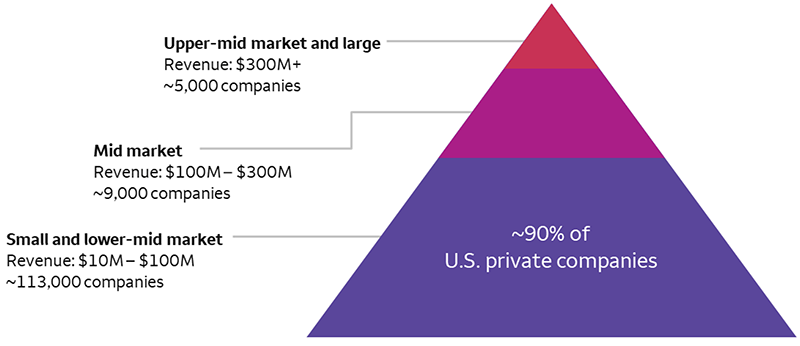May 13, 2025
Mark Steffen, CFA, CAIA, Global Alternative Investment Strategist
Tailwinds supporting small- and mid-market buyout
 Source: Gerber Taylor, “The Role of Private Equity in Portfolios,” Sean Montesi and Kojo McLennon. Data as of October 2021. M = million. ~ = approximately. Excerpted from Investment Strategy report (May 5)
Source: Gerber Taylor, “The Role of Private Equity in Portfolios,” Sean Montesi and Kojo McLennon. Data as of October 2021. M = million. ~ = approximately. Excerpted from Investment Strategy report (May 5)Number of private companies in small and middle markets dwarf larger-market peers
While publicly listed small-cap stocks continue to face headwinds, we believe an opportunity exists in Small / Mid Cap Buyout sub-strategies within the Private Equity strategy.1 In our view, there are longer-term structural advantages as well as several current market dynamics that make this segment of the private-equity market attractive.
One structural advantage is less competition, as shown in the chart above. There are approximately 122,000 companies in the small- and mid-market segments, but smaller buyout funds account for only about 15% of the capital raised according to Pitchbook, meaning fund managers can be more selective on the types of opportunities they invest in. We believe less capital chasing a greater number of opportunities can offer savvy fund managers the potential for high returns.
What it may mean for investors
We remain favorable on Small / Mid Cap Buyout sub-strategies as an improving exit environment, greater access to debt markets, and forecasted lower fed funds rates in late 2025 shape our positive outlook. For more detail on the structural tailwinds and current dynamics we see as supporting these sub-strategies, see our May 5 Investment Strategy report.
1 Small and middle-market businesses are commonly defined as those generating revenues between $10 million and $1 billion.
Risk Considerations
Alternative investments, such as hedge funds, private equity/private debt and private real estate funds, are speculative and involve a high degree of risk that is appropriate only for those investors who have the financial sophistication and expertise to evaluate the merits and risks of an investment in a fund and for which the fund does not represent a complete investment program. They entail significant risks that can include losses due to leveraging or other speculative investment practices, lack of liquidity, volatility of returns, restrictions on transferring interests in a fund, potential lack of diversification, absence and/or delay of information regarding valuations and pricing, complex tax structures and delays in tax reporting, less regulation and higher fees than mutual funds. Hedge fund, private equity, private debt and private real estate fund investing involves other material risks including capital loss and the loss of the entire amount invested. A fund's offering documents should be carefully reviewed prior to investing.
Hedge fund strategies, such as Equity Hedge, Event Driven, Macro and Relative Value, may expose investors to the risks associated with the use of short selling, leverage, derivatives and arbitrage methodologies. Short sales involve leverage and theoretically unlimited loss potential since the market price of securities sold short may continuously increase. The use of leverage in a portfolio varies by strategy. Leverage can significantly increase return potential but create greater risk of loss. Derivatives generally have implied leverage which can magnify volatility and may entail other risks such as market, interest rate, credit, counterparty and management risks. Arbitrage strategies expose a fund to the risk that the anticipated arbitrage opportunities will not develop as anticipated, resulting in potentially reduced returns or losses to the fund.
General Disclosures
Global Investment Strategy (GIS) is a division of Wells Fargo Investment Institute, Inc. (WFII). WFII is a registered investment adviser and wholly owned subsidiary of Wells Fargo Bank, N.A., a bank affiliate of Wells Fargo & Company.
The information in this report was prepared by Global Investment Strategy. Opinions represent GIS’ opinion as of the date of this report and are for general information purposes only and are not intended to predict or guarantee the future performance of any individual security, market sector or the markets generally. GIS does not undertake to advise you of any change in its opinions or the information contained in this report. Wells Fargo & Company affiliates may issue reports or have opinions that are inconsistent with, and reach different conclusions from, this report.
The information contained herein constitutes general information and is not directed to, designed for, or individually tailored to, any particular investor or potential investor. This report is not intended to be a client-specific suitability or best interest analysis or recommendation, an offer to participate in any investment, or a recommendation to buy, hold or sell securities. Do not use this report as the sole basis for investment decisions. Do not select an asset class or investment product based on performance alone. Consider all relevant information, including your existing portfolio, investment objectives, risk tolerance, liquidity needs and investment time horizon. The material contained herein has been prepared from sources and data we believe to be reliable but we make no guarantee to its accuracy or completeness.
Wells Fargo Advisors is registered with the U.S. Securities and Exchange Commission and the Financial Industry Regulatory Authority, but is not licensed or registered with any financial services regulatory authority outside of the U.S. Non-U.S. residents who maintain U.S.-based financial services account(s) with Wells Fargo Advisors may not be afforded certain protections conferred by legislation and regulations in their country of residence in respect of any investments, investment transactions or communications made with Wells Fargo Advisors.
Wells Fargo Advisors is a trade name used by Wells Fargo Clearing Services, LLC and Wells Fargo Advisors Financial Network, LLC, Members SIPC, separate registered broker-dealers and non-bank affiliates of Wells Fargo & Company.


